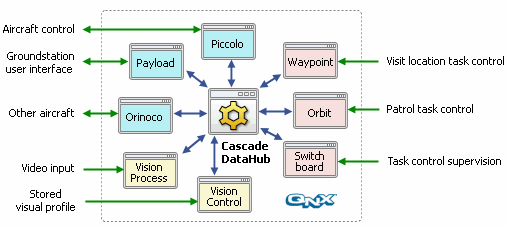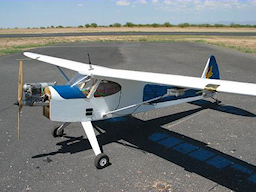 |
||
|
University of California, Berkeley - USA
無人エアクラフト分散制御
過去数年間にわたり、バークレーカルフォルニア大学の車原動力実験室(VDL)の学生達が、無人エアクラフトの分散制御、コミュニケーション及視覚基本制御システムを開発している。 シングルユーザは全エアクラフトを制御することができ、パトロールや境界線の巡回、高速道路の巡回、指定位置の訪問などの複雑なミッションをを実行していた。各エアクラフトは、地上や他のエアクラフトからの情報の伝達ためのビデオカメラやコンピュータを搭載していた。制御アルゴリズムは、大変精巧だったのでミッションにより、オペレータなしでの完全に独立した制御を遂行していた。 The control system for each aircraft runs on a PC 104 computer with a QNX6 operating system. Control is divided into three kinds of processes: communication, image processing, and task control. All of these processes interact through Cogent’s Cascade DataHub. 各エアクラフトの制御システムはQNX6のオペレーション・システム上のPC 104コンピュータで稼動していた。コントロールは3種類の制御に分けられていた。コミュニケーション、画像処理、タスク制御の全ての処理は、Cogent社のCascade DataHubという製品を介して相互されていた。 The Cascade DataHub is a memory-resident, real-time database that allows multiple processes to share data on a publish-subscribe basis. For this application, each process writes its data to the Cascade DataHub, and subscribes to the data of each other process on a read-only basis. Cascade DataHubはメモリー常駐(memory-resident)であり、 a publish-subscribe basis上で複数データ共有のための複数処理がリアルタイムで可能になる。このアプリケーションは、各プロセスでCascade DataHubにデータをカ書き込み、読み込み専用のプロセスによりデータをサブスクライブする。In this way, each process gains access to the data it needs from the other processes, while avoiding problems associated with multi-processing data management. この方法で、各プロセスは他の処理からの必要情報を伝達でき、複数処理データ管理で発生する問題を回避できる。  For example, the communication software comprises three separate processes: The piccolo process controls the aircraft, the payload process communicates with users on the ground, and the Orinoco process handles communications with the other aircraft. Needless to say, each of these three programs needs information from the other two, as well as from the video and task control packages. All of this data is transferred seamlessly through the Cascade DataHub. 例えば、コミュニケーション・ソフトウェアは識別された3つのプロセスによりなりたっている。:Piccoloプロセスはエアクラフトを制御し、Payloadプロセスは地上のユーザと情報伝達し、Orinocoプロセスは他エアクラフトと伝達する役割がある。またご指摘するまでもなく、この各3つのプログラム情報をビデオからの情報同様に制御パッケージからの情報交換もする必要があり、これらの全てのデータがCascade DataHubによりシームレスに伝達されている。 "The Cascade DataHub has contributed a great deal to our software integration," said Brandon Basso, one of the VDL team members. "Its ability to restrict write privileges to each shared variable of the owner processes avoids many of the difficulties associated with multi-process management." VDLチームメンバーの一員であるBrandon Basso曰く。「Cascade DataHubはソフトウェア統合に最適な選択であった。複数処理管理に関連する多数の問題を回避し、各共有variableの書き込みを制限したりできた。」 For task control, there are two primary software packages: Waypoint controls visits to specified locations, while Orbit handles the orbiting "patrol" of a group of locations. These processes are monitored by a third, supervisory process called Switchboard. In addition to coordinating these processes, decisions must be made by the different aircraft as to which plane will take on which task. The complex calculations needed for this decentralized task allocation are mediated through the Cascade DataHub. Waypoint and Orbit use input from the vision control and vision process. Prior to takeoff, certain algorithms are applied to previously recorded videos, to create a visual profile of the area, which is maintained by the vision control. In the air, this data must be compared to what the plane is currently flying over. A camera on the wing of the plane feeds data to the vision process, which analyzes the content and generates meaningful information about objects on the ground, such as waypoints on a river or road. This live content, along with the stored visual profile in the vision control, is fed through the Cascade DataHub to Waypoint and Orbit. According to the paper, A Modular Software Infrastructure for Distributed Control of Collaborating UAVs, published by the University of California Berkeley which describes it in detail, this project marks "a major milestone in UAV cooperation: decentralized task allocation for a dynamically changing mission, via onboard computation and direct aircraft-to-aircraft communication." Cogent Real-Time Systems is proud that the Cascade DataHub has played an important role in the success of this endeavour. |
 For the past several years, students and faculty at the Vehicle Dynamics Lab (VDL) of the University of California, Berkeley, have been developing a system of coordinated distributed control, communications, and vision-based control among a group of several unmanned aircraft. A single user can control the fleet of aircraft, and command it to carry out complex missions such as patrolling a border, following a highway, or visiting a specified location. Each airplane carries a video camera and an on-board computer, and communicates with the groundstation and the other aircraft in the formation. The control algorithms are so sophisticated that the fleet can carry out certain missions completely autonomously—without any operator intervention.
For the past several years, students and faculty at the Vehicle Dynamics Lab (VDL) of the University of California, Berkeley, have been developing a system of coordinated distributed control, communications, and vision-based control among a group of several unmanned aircraft. A single user can control the fleet of aircraft, and command it to carry out complex missions such as patrolling a border, following a highway, or visiting a specified location. Each airplane carries a video camera and an on-board computer, and communicates with the groundstation and the other aircraft in the formation. The control algorithms are so sophisticated that the fleet can carry out certain missions completely autonomously—without any operator intervention.